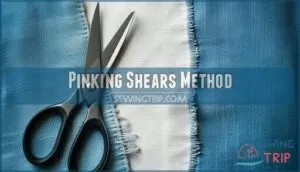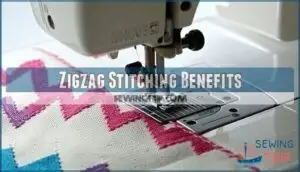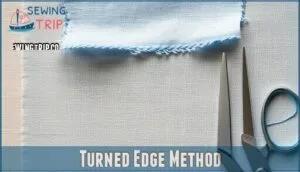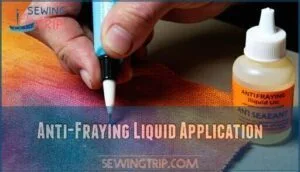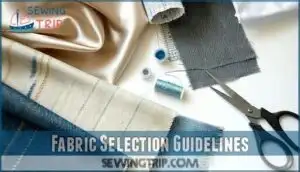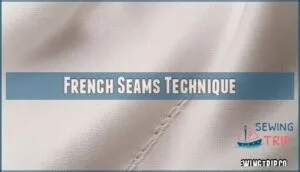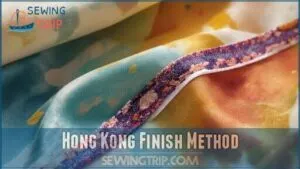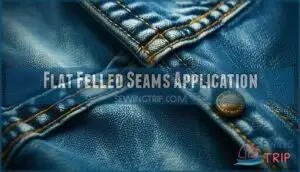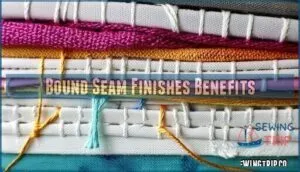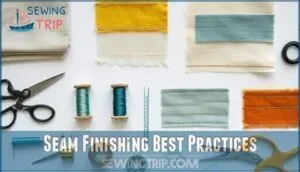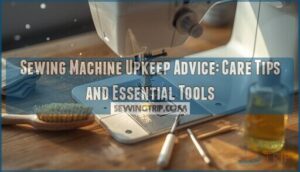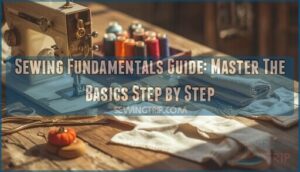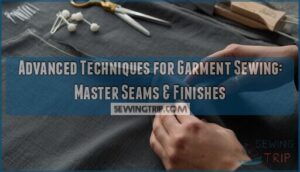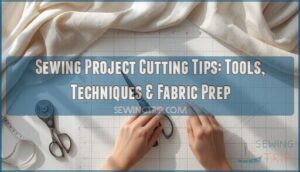This site is supported by our readers. We may earn a commission, at no cost to you, if you purchase through links.
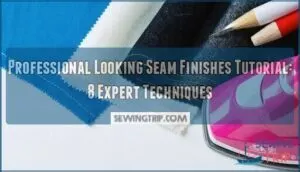
Start with pinking shears for woven fabrics or zigzag stitching for knits to prevent fraying. French seams work perfectly for lightweight materials like silk, while flat-felled seams suit heavier fabrics like denim.
Hong Kong finishes add luxury to unlined garments. Always press your seams properly – it’s the secret sauce that separates amateur work from pro results.
Test your chosen finish on fabric scraps first to avoid surprises. The key is understanding which method works best for different weights and textures.
Some techniques require specific tools that’ll transform your entire sewing approach.
Table Of Contents
Key Takeaways
- You’ll need to match your seam finish technique to your fabric type and weight – use French seams for lightweight materials like silk, flat-felled seams for heavy fabrics like denim, and zigzag stitching for knits to prevent fraying effectively.
- Don’t skip the pressing step since it’s what separates amateur work from professional results – proper heat and pressure flatten seam allowances and create those sharp, clean lines that make your garments look store-bought.
- You should always test your chosen finishing method on fabric scraps first to avoid surprises, as different materials behave differently and what works for one fabric might not work for another.
- Consider fabric opacity when choosing seam finishes because lightweight and sheer materials will show bulky seam treatments through the front, so you’ll want to use techniques like Hong Kong seams that reduce bulk while maintaining a polished appearance.
Choosing Seam Finishes
You’ll need to match your seam finish to your fabric type and weight for the best results.
Consider whether your fabric frays easily and how thick it is, since lightweight fabrics work well with French seams while heavier materials need stronger finishes like flat-felled seams.
Fabric Type Importance
Your fabric type determines everything about seam finishing success.
Fiber content affects how edges fray, while weave structure influences which techniques work best.
Cotton and linen need different approaches than silk or polyester.
Fabric weight impacts your choice too – lightweight materials require delicate handling, while heavy fabrics demand sturdy finishes.
Understanding fabric durability and drape quality guides your decision-making process.
Seam Finish Suitability
Once you understand your fabric’s behavior, matching the right seam finish becomes straightforward.
Consider fabric compatibility first—woven fabrics need different techniques than knits. Your garment type matters too; formal wear demands refined finishes while casual pieces can use simpler methods.
Balance durability needs with aesthetic preferences and cost effectiveness. The perfect seam finish aligns with your project’s specific requirements, ensuring a refined finish that meets your needs.
Fabric Weight Considerations
Weight matters more than you’d think when picking seam finishes.
Lightweight fabrics like chiffon need delicate French seams to avoid bulk.
Medium fabrics work well with standard zigzag or serged edges.
Heavy materials require sturdy flat-felled seams that won’t buckle under pressure.
Consider drape qualities too – bulky finishes can ruin how your fabric falls and moves naturally.
Opacity Impact on Seams
Consider how seam show-through affects your garment’s polished appearance.
Fabric density determines whether your seam finishes will peek through the front side.
Lightweight materials reveal layering effects more than dense fabrics.
Choose bulkier seam finishes for opaque materials and flatter techniques for sheer ones.
Your undergarment choice and lining necessity depend on fabric transparency.
Professional sewing requires matching seam bulk to fabric weight for clean seams.
For sheer fabrics, consider using Hong Kong seams to reduce bulk.
This technique is crucial for achieving a polished appearance with delicate fabrics.
Seam Finishing Techniques
You’ll learn four essential seam finishing methods that prevent fraying and create professional-looking edges on your projects.
These techniques work with different fabric types and give you the skills to choose the right finish for each sewing situation, using essential seam finishing methods.
Pinking Shears Method
Pinking shears create clean zigzag edges that prevent fraying on most woven fabrics.
You’ll get the best results with medium-weight cottons, linens, and wool blends. Keep your shears sharp for crisp cuts—dull blades crush fabric fibers instead of cutting cleanly.
This quick method works perfectly for straight seams and provides excellent fray prevention without additional stitching. For a variety of options, consider purchasing quality shears.
Zigzag Stitching Benefits
Beyond the simple straight stitch, zigzag stitching transforms your sewing game with unmatched versatility.
This technique prevents fraying on various fabric types while offering flexible edge finishing options. Your zigzag stitch adapts beautifully to different materials, making it a go-to choice for both beginners and experienced sewers.
An alternative, the overcast stitch prevents fraying, working on both woven and stretch materials.
Key zigzag stitching benefits include:
- Fray Prevention – Secures fabric edges effectively
- Seam Versatility – Works on woven and knit fabrics
- Stitch Options – Adjustable width and length settings
- Edge Finishing – Creates clean, professional results
Turned Edge Method
The turned edge method delivers exceptional edge durability through simple folding and stitching.
This sewing technique achieves bulk reduction by turning raw edges inward, creating a clean finish that adapts well to curves.
You’ll fold fabric edges 1/8 to 1/4 inch, press firmly, then stitch close to the fold.
This seam finishing tutorial technique offers excellent fabric compatibility for lightweight materials.
This finish is especially useful for achieving a tidy look by enclosing raw edges.
Anti-Fraying Liquid Application
Liquid seam sealants like Fray Check offer quick fabric fraying prevention.
Test different liquid types on scrap fabric first to check fabric compatibility.
Apply thin layers using precise application methods along raw edges.
For a more durable solution, consider employing binding techniques for a professional finish.
Allow proper drying time before handling your project.
These anti-fraying liquids provide excellent longevity effects, making them essential sewing techniques for professional seam finishes.
Fabric Selection Guidelines
Your fabric choice determines which seam finishes will work best for your project.
Natural fabrics like cotton and linen handle differently than blends, so you’ll need to match your finishing technique to your material’s weight, texture, and care needs, considering the complete concepts of fabric handling.
Natural Fabric Characteristics
Natural fabrics bring unmatched Cotton Durability and superior Linen Handling to your sewing projects.
These materials offer exceptional Fabric Quality that elevates any garment’s appearance. You’ll find excellent Comfort Factors in natural fibers, plus access to Vibrant Colors that stay true over time.
When selecting fabric type, consider how woven fabrics and knit fabrics behave differently. Natural materials typically resist fabric fraying better than synthetics, making seam finishes easier to achieve.
For example, cotton offers breathability, making it ideal for everyday comfort.
Blended Fabric Alternatives
Blended fabrics like Ramie Linen offer cost effectiveness without sacrificing quality.
You’ll get enhanced durability and texture variations that mimic pure natural fibers.
These alternatives provide care advantages with easier maintenance while maintaining aesthetic appeal.
When applying sewing techniques and seam finishes to blended materials, you’ll achieve the same professional finish on fabric edges as expensive pure fabrics deliver, ensuring a professional finish and aesthetic appeal.
Texture and Comfort Factors
Beyond cost considerations, fabric feel directly impacts your sewing success and wearer comfort.
The wrong texture choice can turn beautiful couture sewing into an uncomfortable mess, no matter how perfect your seam finishes look.
Consider these texture factors for garment construction:
- Fabric Feel – Rough textures against skin create discomfort
- Seam Irritation – Stiff fabrics need softer sewing techniques
- Breathability – Dense weaves trap heat and moisture
- Drape Quality – Heavy textures affect garment silhouette
- Skin Sensitivity – Scratchy materials require gentle clean finish methods
Care Requirement Considerations
Before you cut that first piece, check the fabric’s washing instructions and drying methods.
Some fabrics shrink dramatically, while others need special ironing needs or stain removal techniques.
Your beautiful seam finishes won’t matter if poor fabric care destroys seam integrity.
Research storage solutions that preserve garment durability.
Smart fabric care directly impacts garment longevity and maintains your professional results.
It is crucial to understand that garment longevity depends on how well you care for the fabric.
Advanced Seam Finishing
You’ll discover four advanced techniques that create professional-quality seam finishes for your best garments.
These methods take more time but deliver superior durability and a polished look that elevates your sewing projects.
French Seams Technique
French seams deliver the ultimate clean finish by enclosing raw edges completely. Start with wrong sides together, stitch at 6mm, then fold and press. Sew again at 1cm with right sides facing.
**French seams transform amateur sewing into couture-level craftsmanship with their perfectly enclosed, professional finish.
This professional finish works beautifully on delicate fabrics.
- Fabric Compatibility: Perfect for lightweight cottons, silks, and tulle application
- Seam Durability: Double-stitched construction prevents fraying forever
- Elegance Factor: Creates couture-level seam finishes without bulk
- Scrap Fabric: Test technique first on leftover material
- Seam Allowances: Requires 1.6cm total for proper encasement
Hong Kong Finish Method
Moving from enclosed seams, you’ll master the Hong Kong finish—a bias tape technique that wraps raw edges like a professional gift.
This clean finish uses bias strip selection and knit fabric choice for flexibility. Color contrast options add visual interest to curved seam application.
The Hong Kong seam creates couture-level results, making ordinary seam finishes look extraordinary through careful bias tape finish execution.
Flat Felled Seams Application
When you need maximum durability and strength, flat felled seams deliver unmatched performance for jeans construction and athletic wear.
This industrial-grade technique creates professional seam finishes that withstand heavy use.
- Durability Benefits: Creates double-layer reinforcement for high-stress areas
- Jeans Construction: Standard method used in premium denim manufacturing
- Industrial Applications: Essential for workwear and heavy-duty garments
- Topstitching Options: Adds decorative contrast while increasing strength
Bound Seam Finishes Benefits
When you master bound seam finishes, you’ll transform ordinary projects into professional masterpieces.
These binding techniques offer superior edge protection while creating custom seams that elevate any garment.
The durability enhancement speaks for itself – bound seams withstand heavy wear better than basic finishes, delivering both aesthetic appeal and fabric compatibility across multiple material types.
| Benefit | Description |
|---|---|
| Durability Enhancement | Bound seams create double-layer protection that resists fraying and wear |
| Professional Look | Clean, finished edges elevate garment quality and appearance |
| Edge Protection | Binding encases raw edges completely, preventing unraveling |
| Custom Seams | Allows creative color contrasts and decorative finishing options |
Seam Finishing Best Practices
You’ll need to follow specific best practices to make your seam finishes look truly professional and last for years.
These proven techniques will help you choose the right methods for your fabric and create clean, durable results every time, using complete concepts to ensure professional finishes.
Pressing Seams Importance
Pressing seams transforms amateur-looking work into professional pieces.
Heat and pressure flatten seam allowances, creating sharp, clean lines that elevate your garment’s appearance.
Proper pressing techniques control fabric placement and enhance durability by setting stitches permanently, giving you that polished look that separates homemade from expertly crafted clothing, and this step directly impacts finish quality by making your work appear more professional.
Decorative Stitches Enhancement
Beyond basic seam finishing, decorative stitches transform ordinary seams into couture details.
Choose thread colors that complement or contrast your fabric for visual impact.
Adjust stitch density to create texture without overwhelming the garment.
Pattern matching becomes essential when embellishment options include decorative overlocking or zigzag variations.
These techniques elevate your work from homemade to clean couture look sophistication.
Eco-Friendly Seam Finishing
Your seam finishes can embrace eco-friendly charm while reducing environmental impact.
Choose biodegradable threads and natural fiber options like organic cotton strips for binding edges.
Scrap fabric binding transforms leftover materials into functional seam treatments.
Low-impact dyes maintain color without harsh chemicals.
For a clean finish, consider using Hong Kong seams.
Adopt a minimalist seam allowance approach and explore waste-conscious alternatives that deliver professional results sustainably.
Professional Finishing Tips
Perfect edge control starts with consistent seam allowances and proper pressing techniques.
Master your edges with precision—consistent allowances and proper pressing separate amateur work from couture-level craftsmanship.
Serger benefits include professional-looking results, but don’t overlook hand-finished alternatives like Hong Kong seam or French seam methods.
Practice patience when creating flat felled seam finishes—rushing leads to puckered fabric.
Test your chosen technique on scraps first.
Durable seams require attention to detail and steady hands throughout the process, using techniques like French seam methods, and ensuring proper pressing techniques.
Frequently Asked Questions (FAQs)
What are the different types of seam finishing techniques?
Don’t put all your eggs in one basket when finishing seams.
You’ve got pinking shears, zigzag stitching, French seams, serging, and bound finishes.
Each technique prevents fraying and adds durability to your projects.
When do you finish a seam?
You’ll finish seams after stitching but before pressing or adding facings.
Always complete seam finishing on garments you want to last.
For quick projects like costumes, you can skip this step entirely, but remember to always consider the durability of your work.
What is a seam finish in sewing?
Ironically, most sewers rush to cut fabric but ignore what happens after stitching.
A seam finish is a technique you’ll use to treat raw fabric edges, preventing fraying and creating professional-looking garments that last.
How do you finish a seam?
Choose your method based on fabric type.
Serge edges for durability, use pinking shears for quick woven fabric finishing, or create French seams for delicate materials.
Zigzag stitching works well for most projects and prevents fraying effectively.
What tools do you need to finish a seam?
You’ll need basic tools like pinking shears, scissors, and a sewing machine with zigzag capability.
A serger makes professional finishes easier, but isn’t essential.
Sharp tools guarantee clean cuts and prevent fabric damage, which is crucial for a professional finish.
Why should you finish seams professionally?
Professional seam finishes prevent fraying, extend garment life, and create polished results.
They eliminate loose threads that cause irritation, improve durability, and give your projects a store-bought appearance that showcases your skills.
Can seam finishes be repaired after washing?
Absolutely disaster strikes when seam finishes fail.
You can definitely repair most seam finishes after washing.
Simply re-serge loose edges, apply new zigzag stitching, or add bias tape binding to restore professional appearance.
What thread colors work best for seam finishing?
Match your thread color to your fabric’s dominant shade for invisible seam finishes. Gray works universally for most colors, while white suits light fabrics and black handles dark tones perfectly.
How do curved seams affect finishing techniques?
Curved seams handle 90% more stress than straight ones.
You’ll need to clip or notch seam allowances before finishing to prevent puckering.
Use shorter stitches on tight curves and grade layers for smoother results.
Should buttonholes receive special seam finish treatment?
Buttonholes don’t need special seam finishing since they’re reinforced during creation. However, if you’re making bound buttonholes, finish the fabric edges first to prevent fraying during construction and handling.
Conclusion
Ironically, achieving professional looking seam finishes tutorial results doesn’t require years of training—just the right technique for your fabric.
You’ve learned eight expert methods that’ll transform your sewing from basic to brilliant.
Remember to test each finish on scraps before committing to your project.
Press every seam properly, choose techniques that match your fabric weight, and don’t rush the process.
Your garments will look store-bought when you apply these professional finishing methods consistently.

